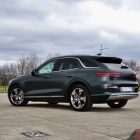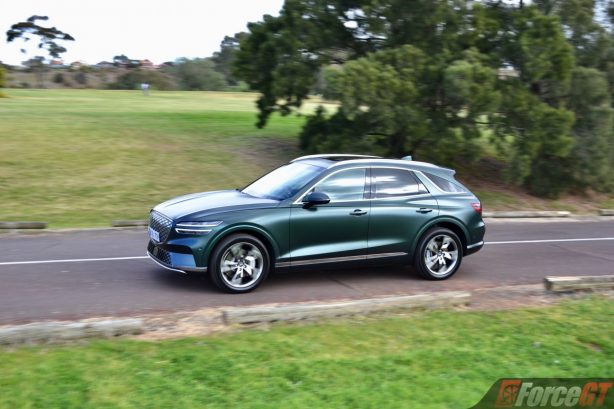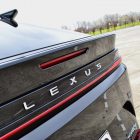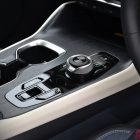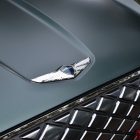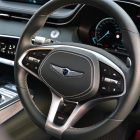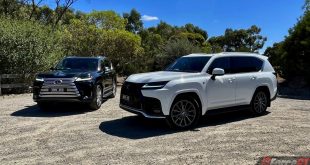Luxury electric vehicles are projected to be one of the biggest sellers in the passenger car market in the coming years. A segment spearheaded by Tesla over a decade ago, today every major premium car manufacturer has a dedicated line of EV offerings – BMW with its i models, Mercedes-Benz with its EQ range and Audi with its e-tron line-up.
While the big three are well and truly onboard the EV bandwagon, challenger brands like Lexus and Genesis have only just started. Lexus, the luxury offshoot of Japanese automotive giant Toyota, is banking on the new fully electric RZ 450e medium SUV for success against the Germans, following lacklustre response to its UX 300e compact SUV, the premium marque’s first EV launched back in 2022.
Genesis, the luxury spin-off of Korean car maker Hyundai, already has a dedicated EV model, the GV60 compact SUV, as well as an electrified version of the G80 sedan. There’s now another zero-emission variant in the form of the Electrified GV70 which is based on the regular engine-powered GV70 medium SUV.
If Tesla’s have become too common and the German offerings don’t float your boat, the Lexus RZ 450e and Genesis Electrified GV70 are both compelling alternatives, which is why we have gathered them here for a comparison review.
How much do they cost?
Both Lexus and Genesis are not restrained when it comes to pricing strategy. The RZ 450e and Electrified GV70 come with hefty price tags, which makes their segment positioning a little blurry.
The RZ 450e is available in two variants, the base spec Luxury which is priced at $123,000 and the upper spec Sports Luxury costing $135,000. The latter can be had in a two-tone finish for an extra $4,200.
Meanwhile, the Genesis Electrified GV70 is offered in a single spec only with a sticker of $127,800. All prices exclude on-road cost.
The pricing positions both the RZ 450e and Electrified GV70 just below rivals like the Polestar 3 and BMW iX, but significantly above models like the BMW iX3, Mercedes-Benz EQB and Tesla Model Y.
They might as well because in terms of dimensions they slot in the same way amongst those competitors. Between the RZ and GV70 though, the former is longer while the latter is wider.
Is there anything interesting about the design?
The RZ 450e is by far Lexus’ boldest looking model, apart from the super sexy LC coupe and the iconic LFA supercar. There’s a lot to take in, from the black accented front bumper and swept back lines to the floating roof and rear light bar. But somehow they all come along harmoniously, producing a design that is very unique, futuristic and sophisticated.
The Sports Luxury model tested here boasts striking multi-spoke 20-inch wheels tucked within black painted wheel arch mouldings.
The Electrified GV70 is much more conventionally styled as compared to the RZ 450e. Granted, it’s based on the regular GV70 which in itself is a pretty sweet looking luxury SUV. Unlike the engine-powered models, the grille is sealed with the charging port neatly concealed within. In the rear, the absence of tailpipes is the only giveaway of its electrified propulsion.
Our test vehicle rolls on standard 20-inch wheels and is draped in the optional $2,000 matte green paint which looks amazing.
How is the interior like?
Echoing the exterior, the RZ 450e’s interior radiates a very modern and contemporary feel. It’s unlike the usual warm, rich and luxurious cabins we have been used to seeing in Lexus models. In fact, the RZ’s cabin looks so cool it’s not very Lexus-esque at all.
That’s because the RZ cabin focuses on sustainable construction, with heavy usage of environmentally-friendly materials including a vegan upholstery called Ultrasuede (on Sports Luxury model), a sustainable suede material made partly from biomaterials and recycled PolyEthylene Terephthalate (PET).
If you’re skeptical about this type of upholstery, afraid not because it feels supremely comfortable. Applied on the seats and doors, it looks very high end, too. Our tester is trimmed in the two-tone interior colour scheme called Storm (exclusive to Sports Luxury) which pairs light bluish grey suede seat upholstery with white synthetic leather door and centre console trim. The dashboard is a matching grey colour. The combined effect is an open and airy cabin feel.
Speaking of which, the RZ features some next level tech in its panoramic glass roof to control cabin lighting and temperature. At the push of a button the clear roof turns opaque to block out some light, eliminating the need for sunshade. It’s one of the coolest things we’ve seen in a vehicle.
The cockpit of the RZ consists of a massive 14.0-inch touchscreen display infotainment system. The interface is a big step up from previous Lexus systems in terms of screen resolution and intuitiveness. It supports wireless Apple CarPlay and wired Android Auto.
Not as impressive is the digital instrumentation cluster which is so small that it only takes up half the cluster space. The graphics aren’t that crisp either.
Taking on a very different approach, the interior of the Electrified GV70 is sheer opulence and indulgence. It feels much more expensive and sophisticated than the Lexus, with higher grade materials and more delicate switchgear throughout. The cabin mood lighting, changeable in colours, truly lifts cabin ambience at night.
The seats, upholstered in fine Nappa leather with white contrast stitching, look more premium than those in the RZ, though they’re not as cocooning.
Matching the RZ in screen size is the 14.5-inch touchscreen wide display infotainment system which can be operated by touch or a remote control in the centre console. While the screen itself is superbly sharp and very responsive to the touch, the remote controller can do with some improvement. Because the control combines a rotary dial, arrow buttons and a round touchpad all into one, it is confusing to use. It needs to be simplified. You can use touch but the screen is quite a stretch. Wired connectivity for both Apple CarPlay and Android Auto is supported.
Ahead of the driver is a 12.3-inch 3D instrument cluster that gives a sense of depth to the virtual gauges. While it doesn’t offer much customisability, it’s still leaps and bounds ahead of the RZ’s cluster.
How much space is there inside?
Packaging is slightly better in the Lexus than in the Genesis. In the former, the seats and door cards are less chunky, resulting in more interior space. The floor is also flatter in the back of the RZ, giving more leg space to the middle rear passenger. Both cars can accommodate five people quite comfortably but those seated in the Lexus will have just a little more room to move about. But when there’re three adults seated across the rear bench, they’ll have more shoulder room in the Genesis thanks to its slightly wider cabin.
Built from the ground up as an EV, the RZ’s interior is not shared with other non-EV Lexus models and so there’s more freedom to carve out more storage space, taking advantage of the drive shelf-less nature of EVs. The open lower storage pan in the centre console is an extra storage space in the RZ 450e that the Electrified GV70 lacks due the latter having to share its cabin with fuelled versions of the car. However, the RZ doesn’t have a glovebox which can be a little inconvenient.
Boot space is larger in the RZ at 522 litres compared to the GV70’s 503 litres. It’s another story when the rear seats are folded, with the Genesis packing 1678 litres against the Lexus’ 1451 litres.
How do they drive?
Both EVs are motivated by dual electric motors, with the RZ 450e packing a combined output of 230kW/435Nm, up against the Electrified GV70’s much more potent 360kW/700Nm. There’s certainly quite a big difference in power output but not in the way they drive.
Lexus prides itself on making some of the most refined and quietest cars in the market. You can only expect its first from-the-ground-up EV to be even more serene and hushed. And that’s exactly how the RZ 450e drives. It is literally whisper quiet in all proceedings, be it accelerating, cruising or braking. Unlike other EVs or hybrids, there’s a distinct absence of whine from the electric motor, with the silence pierced only by wind and tyre noise, but even that is very much suppressed.
With a highly insulated cabin, the Electrified GV70 is very much muted as well but it’s no match for the Lexus, for there’s still a very slight whine from the electric motor – if you pay enough attention.
With a belly full of batteries, both SUVs are heavy vehicles weighing over two tonnes. And so neither cars are particularly sharp to drive, with weight a constant companion around tight corners. They aren’t clumsy per se, as they still thread through corners nicely. They just don’t like to be rushed.
That said, the RZ 450e’s lighter and more responsive steering tune does give a sportier and nimbler driving feel. Overall control is also better in the Lexus, thanks in part to the amazing grip and response from its ‘Direct4’ all-wheel drive system where driving and braking force is distributed individually to each wheel.
Where the electrified GV70 triumphs over the RZ is in acceleration. Nudging 100km/h from standstill in 4.2 seconds, the Electrified GV70 sprint time is over a full second quicker than the RZ’s 5.3 seconds. Maxed out, the Genesis tops 235km/h which also trashes the Lexus’ 160km/h.
Both cars deliver high levels of ride comfort but the GV70 feels just a little smoother at low speeds over rougher bitumen.
How about efficiency and charging?
The RZ 450e’s reported driving range fluctuates quite a bit depending on how you drive, meaning it’s tricky to know how much actual range is remaining. On paper, the RZ is good for 395km (WLTP) on a full charge, but we think that’s optimistic. The Electrified GV70 has a longer range of up to 445km (WLTP) and it does seem to deliver quite close to that figure.
Indeed, the reported real world efficiency is better in the GV70 at 19.3kWh/100km compared to the RZ’s 20.8 kWh/100km. This comes as a surprise as the Lexus is lighter and rides on skinnier tyres.
Both cars support the usual domestic 1.8kW AC, 11kW/22kW AC and 50kW DC charging, but the RZ’ charging rate maxes out at 150kW while the GV70 is capable of up to 350kW. The Lexus’ DC charge time is noticeable slower as well, the smaller capacity battery is to blame.
The RZ’s charging port is located at the base of the A pillar making it hard for charging cable to reach at public charge points. The GV70’s charging port in the grille is much easier to get to.
Verdict
The Lexus RZ 450e and Genesis Electrified GV70 may not be the most efficient or sportiest EVs around. Their pricing isn’t that attractive either. But if you value longevity and reliability, both vehicles may have the advantage over their European competitors.
As a bespoke EV model in Lexus’ line-up, the RZ 450e boasts unique styling that’s backed by a wonderfully refined drivetrain and decent dynamics. However, it’s let down by a dated and small digital instrumentation cluster and short driving range.
In contrast, the Electrified GV70 impresses with an ultra luxurious cabin with a modern cockpit, while delivering a greater driving range. It also costs over $7,000 less than the Lexus.
When the brief is about mid-size premium electric SUV, luxury and driving range is key, and the Electrified GV70 seems to have delivered across those fronts a little better than the RZ 450e.
Let us help you get the best deal on your next new car. Contact us.
| 2024 Lexus RZ 450e Sports Luxury | 2024 Genesis Electrified GV70 | |
| Design and Comfort | 8.5 | 8.5 |
| Performance and Handling | 8.0 | 7.0 |
| Quality | 8.0 | 9.0 |
| Economy | 7.0 | 7.5 |
| Equipment and Features | 7.5 | 8.0 |
| Overall | 39/50 | 40/50 |
Pricing and Specification
| 2024 Lexus RZ 450e Sports Luxury | 2024 Genesis Electrified GV70 | |
| Price (excl. on-roads): | From $135,000 As Tested: $136,750 Options fitted: Premium Paint ($1,750) | From $127,800 As Tested: $129,800 Options fitted: Matte Paint (2,000) |
| Warranty: | 5 years, unlimited km | 5 years, unlimited km |
| Warranty Customer Assistance: | 5 years | 5 years |
| Service Intervals: | 12 months, 15,000km | 12 months, 15,000km |
| Country of Origin: | Japan | South Korea |
| Power Unit: | Dual electric motors, Lithium Ion battery: 230kW/435Nm | Dual electric motors, Lithium Ion battery: 360kW/700Nm |
| Drivetrain: | All-wheel drive | All-wheel drive |
| Power-to-Weight Ratio (W/kg): | 108.5 | 138.5 |
| Energy Consumption (kWh/100km): | Claimed: 15.2/Tested: 20.8 | Claimed: 19.3/Tested: 19.2 |
| Max Charging Capacity (kW): | 150 | 350 |
| Body: | 5-door SUV | 5-door SUV |
| Safety: |
|
|
| Dimensions (L/W/H/W-B): | 4,910/1,895/1,635/2,850 | 4,715/1,910/1,625/2,875 |
| Towing Capacity (kg): | Braked: 750/Unbraked: 750 | Braked: 1,800/Unbraked: 750 |
| Tare Mass (kg): | 2,120 | 2,310 |
| Entertainment: |
|
|
 ForceGT.com Car News, Car Reviews, Video Reviews, Tuning and much more.
ForceGT.com Car News, Car Reviews, Video Reviews, Tuning and much more. 


















